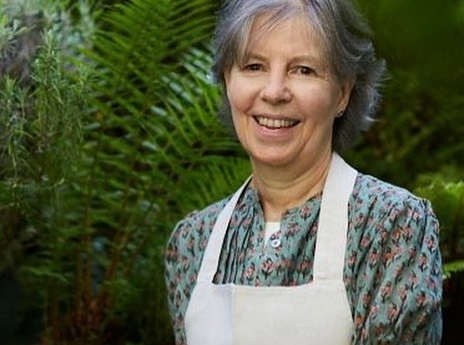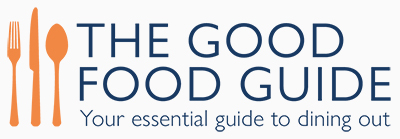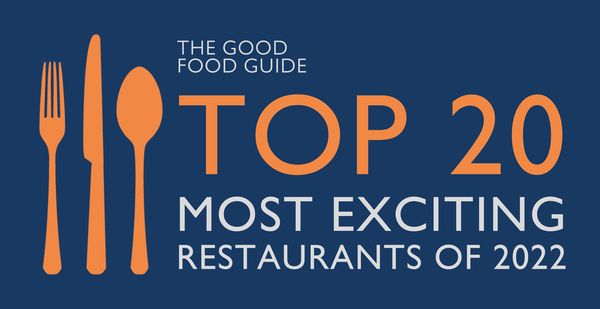 The Good Food Guide 1986
The Good Food Guide 1986
This has the style of a country restaurant, with high ceilings, cream walls, flowers, and no choice on the menu, which changes daily. Sally Clarke arrived via Croydon Technical College, Paris and Michael’s in Santa Monica. The Californian influence is the most noticeable with a strict use of fresh ingredients, plenty of charcoal grilling, marinating, and no vinegar in the dressing of the salads. Typical are the chicken soup with tapenade, and duck marinated in red wine, grilled but still pink, and served with its reduced marinade and homemade noodles. Fish features strongly, from marinated salmon and monkfish, to char-grilled salmon, to kebabs served with anchovy and black olive purée, to skate in black butter. The third course is always a fine, cottage-made cheese. Often these are rare: a Satterleigh, an Exmoor, a Devon Garland, and a Belvoir Blue were served on successive nights one week, all with homemade bread and biscuits. Sweets range from chocolate cake to blood oranges with a slice of Sauternes and olive oil cake. The developing menu means that standards are not sufficiently consistent for a rating of 14. There is usually an alternative in the kitchen if there is something you don’t like. Upstairs is said to be better than down, which echoes cavernously because of the hard floors and where you can get some of the cooking smells. Sally Clarke’s eye for detail in all things extends to the wines. The list is also evolving but includes quality bottles at a reasonable price. The house aperitif is blood oranges with champagne. There is also Exshaw cognac.
 The Good Food Guide 1990
The Good Food Guide 1990
This short stretch of Kensington Church Street is home to two particular leaders in up-to-the-minute London restaurants as, decades ago, the Ark round the corner drew all the young fashionables. Sally Clarke has continued to attract plaudits for one of the few no-choice dinners in the capital and a style of cookery usually typed as Californian but which may be described as sophisticated natural – that is, not natural at all. The restaurant is on two floors: a small room with a shop window at pavement level, with a tiny dispense bar at the back and a potential draught from the front door, then downstairs to a cool, light basement, deceptively large, with an open kitchen giving out on to one corner. The atmosphere is wonderfully fresh – striking a chord, perhaps, with the food and cooking. Next door is Clarke’s shop. Every small restaurateur dreams of a retail outlet where the surplus energies (and dead time) of the kitchen may be turned to profit; few achieve the reality. Clarke’s has done, largely through bread. Every midnight, the baking shift begins. The loaves, in many varieties, are some of the best (and most expensive) in London, sold along with truffles, pizza, tarts, cakes and cheese supplied by Neal’s Yard, and served in the restaurant (not much is left by 2pm).
Sally Clarke has not deviated from her initial schema: lunch is a good-value but short menu of three dishes in each course (fewer if you come late), while dinner is a no-choice four-course affair. Each is at an all-in price, though ‘supper’ is offered later in the evening, as an abbreviated dinner. Menus for the evening are planned a week in advance, thus allowing for allergies and violent dislikes to be coped with if notice is given. Sally Clarke cooks lunch herself but normally comes front-of-house at dinner. The char-grill dominates the style of cooking, olive oil the palette of flavour. Clarke’s must use more olive oil than all the trattoria of old Soho put together. There are times when the cooking seems little more than assembly: cubes of marinated salmon, for instance, may arrive with cubes of cucumber, an unseasoned yoghurt dressing, some smart red leaves, smarter oil and a wedge of toasted rye bread. By contrast, a grilled breast of guinea fowl of superlative flavour with crisp charred skin came with an intensely garlicked red pepper and parsley relish and a fine thin juice. This showed judgement in timing and balance of flavours. The simple approach is a tight rope strung between the quality of the ingredients and the skill of balancing them with the right accompaniment. A spring lunch had a chicken with insufficient taste set next to an inert and gutless pesto, the whole swamped in too much olive oil. But the general voice is that there are few slip-ups. Though unwilling to be thrust into a Californian ghetto, Sally Clarke uses Alice Waters’ recipes more than almost anyone else’s – Giradet and Wolfgang Puck also enter her pantheon of sources. The Alice Waters’ rich chocolate cake that can often be found on the menu (and in the shop) is nigh-on the best chocolate cake made in Britain today: a masterpiece of rich understatement. The wine list is in keeping with the cooking: not too long, wisely chosen, well served. Although there is a French presence (good at that), the Californians are first class. Clarke’s is one of the small number of restaurants that succeed in feeding and nourishing without overload. It has been remarked that women chefs are often gentler on the digestions of their customers than men. Whether this is the natural economy of their gender or the subtlety of their judgement is not settled. A conservative diner commented on leaving that he appeared to have been served nothing at all (and no potatoes), yet felt in perfect equilibrium.
 The Good Food Guide 1996
The Good Food Guide 1996
‘ "Simple" would be the word I use, in a complimentary sense,’ begins a typical report. Another adds that ‘once you come to terms with the fact that Clarke’s is about super-fresh Mediterranean and Californian salads, quick charcoal grilling, simple desserts, fine British cheeses and great bread, then it is hard to find much fault in the beautifully balanced clean tasting no-choice meals.’ Lightness remains a characteristic, and chargrilling is applied to everything, from leg of lamb through corn-fed chicken to breast of guinea fowl. Entering the ground-floor dining-room is just like walking into a shop, while the downstairs one is pine-floored and decorated with abstract paintings and flowers in green ceramic pots.
It is, maintains Sally Clarke, her private army of vegetable, salad and fruit growers who plan her menu. If so, they seem to be a remarkably well-organised bunch. ‘Menus are posted at the beginning of the week, dispelling any notion that our Sally is at the market at five every morning, picking the freshest ingredients and shaping the menu around them.’ A Wednesday meal gives the flavour, beginning with sweet and tender pigeon, lightly grilled, watercress, raisins, and ‘the tiniest wetting of pan juices and a squeeze of blood orange’, then sweet, firmly textured grilled fillet of brill served with tarragon, chives and a rösti-like potato pancake. Two British cheeses follow, with ‘wonderful, thin oatmeal biscuits,’ and finally a ‘rich hemisphere of white, creamy and very vanilla-ish pannacotta with stoned cherries and two superb almond biscuits’.
In these circumstances chargrilling naturally gets put under the microscope, and when two scallops and a fillet of salmon are barbecued on the same skewer, each needing different cooking times, then ‘this can be cause for concern’. Although simplicity is at the heart of Sally Clarke’s cooking, there is a view that ‘I don’t go out to an expensive restaurant to have grilled chicken breast.’ As one reporter puts it, ‘The niggle comes from knowing that the chefs have not slaved for hours over turbot carcasses or veal bones, nor made labour-intensive purées.’ The chargrilling may be of the best, but it explores a limited range of the repertoire, and reporters are aware of other restaurants’ wider range of flavours and textures, brought about by additional cooking methods. The deliberately uncomplicated formula should reflect a little better in the pricing.
Wines, however, are well thought out and not greedily marked up, with good bottles from Italy and particularly California, including some from Bonny Doon. Although vintages are recent, the wines are ready to drink and cover a broad spectrum of flavours. Ten or twelve interesting ones are usually available by the glass from £2.50.
 The Good Food Guide 2008
The Good Food Guide 2008
After 24 years, Sally Clarke's vibrant, exciting and very delicious food continues to enthral at her eponymous restaurant, which is set amid the antique shops of Church Street. Eating takes place on two levels, a small ground floor area and the much more relaxing, low-lit basement room with its open-plan kitchen. She has wavered little from her tried and tested formula: using impeccable, seasonal ingredients to produce simple but perfectly executed dishes. The only change in recent years is that she now offers a choice of dishes in the evening, and it is no longer necessary to have all four courses. Lunch is a selection of four starters, three main courses, and either cheese or a couple of puddings, and dishes are priced individually. Dinner often kicks off with a salad – perhaps peas, grilled spring onions and pea shoots with San Daniele ham and a crème fraîche dressing. To follow, there may be chargrilled Angus ribeye with parsley, lemon and garlic butter and hand-cut chips, or halibut baked ‘en papillotte’ with Jersey Royals, shallots and tarragon and served with roasted fennel and beetroot. First-class cheeses with oatmeal biscuits precede imaginative desserts: say, warm-baked cherry soufflé pancake with bay-leaf ice cream. The wine list is a pick and mix of good and prestigious bottles from around the globe. Prices climb steeply from the £15 starting point.
 The Good Food Guide 2012
The Good Food Guide 2012
When Sally Clarke brought char-grilling and sun-drenched Californian flavours to Notting Hill back in the 80s, it was hailed as revolutionary stuff bursting with new-age vitality. Some 27 years down the line, she is one of London's culinary icons with an MBE to her name, but she hasn't lost her appetite for direct, sense-tingling food. Seasonal clarity is her touchstone and the flavours hit you head-on – a salad of shaved purple artichokes and fennel with buffalo mozzarella and citrus dressing, for example. Although the Mediterranean influences are unmistakable, Sally has never watered down her commitment to native produce, serving Cornish squid with salsa verde, organic spelt and spiced cime di rape, enlivening home-smoked Aylesbury duck breast with blood oranges, and deploying Devon roe deer for a slow-cooked pie with winter truffles. British cheeses come with fig 'salame', and desserts might include Yorkshire rhubarb with Campari sorbet and brown sugar palmier ('an excellent combination of flavours and textures'). California dreamers will dote over the West Coast treats on the handpicked wine list (note the section devoted to Ridge Vineyards), but there are top names from France, Italy and the Antipodes too. Prices from £19.
 The Good Food Guide 2016
The Good Food Guide 2016
More than three decades since Sally Clarke set up shop here, she remains a hands-on presence and a key part of the ‘friendly, welcoming’ atmosphere that keeps guests coming back for more. A year or so ago she moved her café-bakery-deli to a new home over the road, allowing expansion of the restaurant, which now includes a new kitchen and private dining room below. ‘Slightly chaotic’ on busy nights, but with staff always ‘doing their best’, it continues to turn out classically-inspired dishes with gentle modern touches. Handmade spinach and potato gnocchi with crisp sage, pea leaves and aged Parmesan typifies the fresh, lively flavour, followed perhaps by char-grilled veal chop with pine nut, raisin and parsley pesto and parsnip chips. To finish, maybe spring rhubarb and pistachio trifle with vanilla cream. An interesting global selection of wines starts at £20.
 The Good Food Guide 2018
The Good Food Guide 2018
Sally Clarke’s stalwart Kensington dining room, established in 1984, continues to receive plaudits for its ‘super-attentive’ service and ‘no fuss’ attitude. This approach matches the kitchen where British and Italian ingredients, flushed with seasonal promise, are respectfully united on a menu occasionally redolent of a bourgeois dinner party. But simple things, such as gazpacho or smoked salmon with capers and crème fraîche, become special things with the right accompaniment – herbed breadsticks in the case of the former, rye wafers the latter: Clarke’s baking is rightly famous. Generous mains are ‘ably cooked and decoratively presented’, for example, roasted turbot on the bone with samphire and Prosecco or Lancashire duck and purple figs. Chocolate brownie comes with peanut ice cream pronounced ‘so good that the recipe was requested’. Fireworks are few, but that’s not to underestimate the pleasure of prime ingredients perfectly matched with a rare Californian or European bottle from the cellar.







